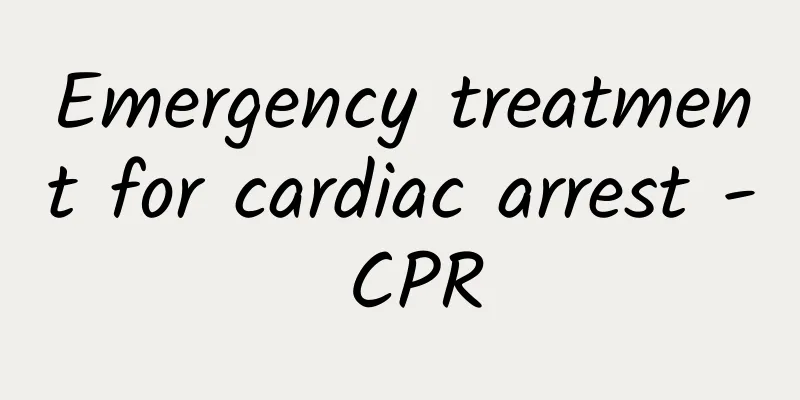Emergency treatment for cardiac arrest - CPR

|
Various factors such as various types of trauma, drowning, electric shock, poisoning, and acute illnesses all have the risk of causing respiratory and cardiac arrest. When sudden death occurs around us, the rescue method of effective artificial respiration and chest compression for this emergency is called cardiopulmonary resuscitation, abbreviated as CPR. In our country, about 544,000 people suffer from cardiac arrest each year, and an average of one person dies suddenly every minute. This emergency can happen at any time, any place, and to anyone. Once cardiac arrest occurs, all organs of the human body will be deprived of oxygen. Our brain, once deprived of oxygen for 4-5 minutes, will suffer irreversible damage. Even if the heartbeat is restored later, it may become a vegetable. Therefore, the golden rescue time for cardiac arrest is four minutes, known as the "golden 4 minutes". For every minute of delay, the chance of survival of the injured person decreases by 10%. According to a survey, the success rate of rescuing out-of-hospital cardiac arrest in my country's major cities is only about 1%, while the average in developed countries is about 10%, and in some cities and regions it is as high as 30-50%. One of the main reasons for this gap is the low penetration rate of public first aid in my country. The first witnesses at the scene lack the necessary first aid knowledge and skills, making it difficult to save lives and reduce injuries to the greatest extent, and to create conditions and gain time for treatment by professional medical institutions. Hands-free cardiopulmonary resuscitation is an operation that is easy to master and can quickly and effectively treat the wounded. In recent years, the country has also actively promoted and popularized it. Key points of cardiopulmonary resuscitation Operation steps: confirm the safety of the environment, identify cardiac arrest, activate the emergency response system, start CPR as soon as possible, and perform early defibrillation. (1) Environmental safety: First, when helping others, you must protect yourself first and make sure that the on-site environment is safe and suitable for rescue. For example, you can evacuate pedestrians around you first. If you are on the road, you must put up warning signs to allow other vehicles to bypass. (2) Judgment: Next, we start to judge the reaction. We kneel on the ground, pat the patient's shoulders, and shout loudly next to his ear. If the patient does not respond at this time, we will open his clothes, observe whether the chest is rising and falling, and judge the pulse by touching the carotid artery. We need to check the pulsation of the carotid artery (non-professionals do not need to check). Under normal circumstances, you can feel the carotid artery by putting two fingers on both sides of the midline of the neck. This place is close to the heart, so the pulsation will be very strong. Once the heart stops beating, you will not be able to feel the pulse. If the patient is unresponsive, the chest is not rising or falling, and there is no arterial pulse, we must perform CPR immediately. (3) Activate the emergency response system: It is very difficult to save lives with our own hands, so we must seek help from people around us. Designate someone around you to call 120 and clarify your location, while another person goes to get an automated external defibrillator. Currently, automated external defibrillators have been deployed in public places in Zhengzhou, such as subway stations. (4) Start CPR as soon as possible: ① The chest compression position is at the midpoint of the line connecting the two nipples. Use the heel of your palm to press, cross your hands and lift them up, straighten your forearms and upper arms without bending them, and press down with your upper limbs perpendicular to the patient's body. The compression depth for adults is 5 to 6 cm. The frequency is 100-120 times per minute. ② Open the airway. Before ventilation, we must first clean the patient's oral and nasal secretions. We generally use the head tilt and chin lift method. For patients who may have cervical spine injuries, we use the jaw support method. ③ Artificial respiration. While opening the airway, blow air into the patient. When blowing, pinch the patient's nasal cavity with your hands. The rescuer covers the patient's mouth with his own mouth, and then blows evenly and slowly for 2 times. When blowing, be careful not to take a deep breath and blow it out violently. Instead, inhale calmly and blow air slowly. When you see the patient's chest bulge, the blowing is effective. Each blowing time should not be less than 1 second, and the blowing volume is about 500 to 600 ml. Chest compressions and artificial respiration should be performed in a ratio of 30:2, that is, 2 artificial respirations should be performed after every 30 chest compressions. It should be noted that if the patient is a child or an infant, the compression and breathing ratio of a single person rescuing is the same as that of an adult. If two people are rescuing at the same time, the compression and breathing ratio should be changed to 15:2, that is, 2 artificial respirations should be performed after every 15 chest compressions. (5) Early defibrillation (automatic external defibrillator): The automatic external defibrillator can automatically analyze the heart rate and determine whether the patient needs defibrillation. If necessary, it will automatically perform defibrillation. How long should CPR be performed? Will it cause harm (breaking the patient's ribs)? If you encounter a patient with respiratory and cardiac arrest, please continue to press and blow until the patient recovers spontaneous breathing and heartbeat, or professional medical personnel arrive to take over the rescue work. Cardiopulmonary resuscitation is very physically demanding, so before the medical staff arrives during the rescue process, you must actively seek assistance and cooperation from people around you. When we are doing CPR, we may have some concerns about whether the patient will be harmed during the rescue process, such as breaking the patient's ribs, and whether we need to bear legal responsibility? If the rescuer causes damage to the person being rescued due to voluntary emergency rescue, the rescuer shall not bear civil liability. Therefore, if you encounter someone who needs rescue, please step forward bravely to rescue him. The pressing position is the midpoint of the line between the two nipples, or the lower half of the sternum Place the base of one hand in a pressing position Cross your hands and hold them tightly, with four fingers raised 1 Cross your hands and hold them tightly, with four fingers raised 2 Stretch your arms straight and press straight down (Wang Peisong and Li Shengyun from the Clinical Skills Training Center of the First Affiliated Hospital of Zhengzhou University) |
<<: How to identify stroke early? Remember the motto "BE FAST"
>>: Analysis: Facebook's advertising woes
Recommend
Can a 17-year-old with flat breasts still develop?
Can a 17-year-old with flat chest still grow and ...
What to eat during menstruation to detoxify, remove blood and lose weight
Women spend about a quarter of their month experi...
Menstruation is 20 days late and has not come
If a female friend's menstruation is delayed ...
Why does a girl have stomach pain?
Many women experience some physical discomfort in...
Can I eat chopped peppers during menstruation?
Can you eat chopped chili peppers during menstrua...
What to do if the endometrium is 28mm thick
Female friends pay great attention to the thickne...
What do the three categories of regions in Tibet mean? How many living Buddhas are there in Tibet?
Tibet is mysterious, a plateau, a Tibet, a fronti...
Do you know these things about high blood pressure?
The theme of this year's World Hypertension D...
Picture of fetus in second month of pregnancy
A fetus in the second month of pregnancy is about...
Does the vagina change after giving birth?
Women attach great importance to their vaginal he...
What should women with acne eat to detoxify?
Everyone will inevitably get acne in life. Acne i...
If you wake up 100 times every night, can you still say you slept well?
Late at night, you wake up from sleep, and the al...
The process of spontaneous abortion
There are two types of miscarriage: voluntary mis...









